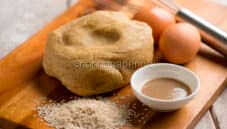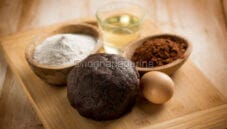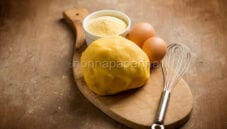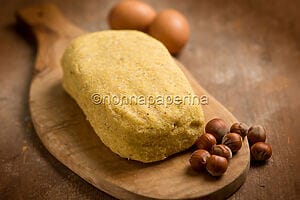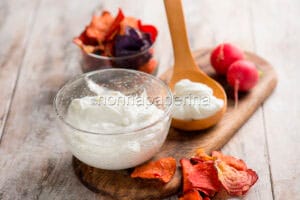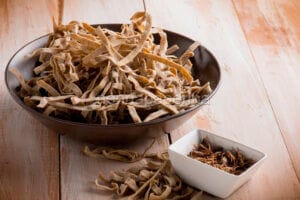
Hazelnut shortcrust pastry, a good and versatile base

Hazelnut shortcrust pastry, perfect for tarts and desserts
I’m going to share with you today a delicious take on the traditional shortcrust pastry: the hazelnut shortcrust pastry. It is distinguished by the high concentration of hazelnut flour, which produces significant flavour alterations and permits celiacs to eat it.
Making the hazelnut shortcrust pastry is easy; just follow the same steps as making the traditional shortcrust pastry. Simply mix all the ingredients together, give them a hand kneading, and form into a ball of dough. After that, cover this with clingfilm and refrigerate for 30 minutes. Once the resting period is over, the shortcrust pastry can be rolled out and used in a variety of dishes, such as tarts, cakes, and biscuits.
In terms of cooking, 20 to 25 minutes at 160 degrees Celsius (320 degrees Fahrenheit) in an oven that has been warmed is adequate.
Recipe hazelnut shortcrust pastry
Preparation hazelnut shortcrust pastry
To prepare the hazelnut shortcrust pastry, follow these steps.
- Combine all the ingredients, knead until sufficiently solid, then form into a slightly flattened ball.
- Wrap the ball of dough in cling film and let it rest in the fridge for 20-30 minutes.
- Once this time has passed, preheat the oven to 150 degrees.
- Place the dough between two sheets of baking paper, and roll it out with a rolling pin until it is half a centimetre thick.
- At this point, the shortcrust pastry is ready to be used for biscuits, tarts, etc. In the latter case, you could line the tart mould, fill it with compote, and cook for 20–25 minutes.
Ingredients hazelnut shortcrust pastry
- 100 gr. of hazelnut flour
- 100 gr. of coconut flour
- 2 large eggs
- 125 gr. of clarified butter
- 55 gr. of coconut sugar
- 1 generous teaspoon of orange zest
- 1 pinch of salt
- half a teaspoon of cream of tartar or baking soda
The properties of hazelnut flour
The hazelnut flour is undoubtedly the star of this shortcrust pastry. Because it is gluten-free and suitable for celiacs, it is an ideal substitute for flour. It is distinguished from other flours by its unique nutritional qualities. Since it contains very few carbohydrates, it is appropriate for the popular ketogenic diets. However, it has a lot of healthy fats that are beneficial for circulation. It is the highest-calorie flour available, containing 600 kcal per 100 grammes due to its high fat content.
In terms of other micronutrients, vitamin E, which is present in hazelnut flour, is valued for its functions as an immune system stimulant and antioxidant. It is also rich in mineral salts, including phosphorus, magnesium, and potassium.
What role does coconut play in the hazelnut shortcrust pastry?
There are certain derivatives of coconut on the list of ingredients for hazelnut shortcrust pastry. As an illustration, coconut flour is used to reduce the rather overly “toasted” flavour of hazelnut flour. Additionally, coconut sugar is available, which may be used in place of ordinary sugar and offers a unique touch that balances the flavour.
The properties of coconut sugar and flour are identical to those of the products they substitute. Coconut flour is highly effective, particularly in situations where leavening is not required. While it doesn’t sweeten as much as brown sugar or honey, coconut sugar does sweeten somewhat.

Which butter is to be used in this recipe?
Just like standard shortcrust pastry, hazelnut shortcrust pastry also relies on the presence of butter. Butter has an impact from an organoleptic point of view, guaranteeing a “soft” and vaguely milky flavour. It has an impact above all from a texture point of view, binding the ingredients better and helping to form homogeneous doughs. However, be careful about the type of butter. You will be tempted to use regular butter, which is also more available, but I recommend choosing clarified butter.
Clarified butter is unique in that it doesn’t contain caseins, which has certain implications. Firstly, it shows a noticeable heat resilience, to the extent that clarified butter can be cooked with just as much ease as any other vegetable or animal fat.
It also establishes a softer, more subtle flavour. This prevents the butter from covering the other ingredients and affecting the outcome. The complete lack of lactose in clarified butter is another benefit; this is particularly significant for people who are lactose intolerant. The calorie intake is extremely similar to that of pure fat, which is the main drawback.
How to thicken and bind hazelnut shortcrust pastry?
Because shortcrust pastries are brittle, binders and thickeners are frequently used to support them. Regarding the hazelnut shortcrust pastry, I suggest using a generous amount of cream of tartar right away. It is among the best ingredients ever discovered for stabilising and improving the consistency of dough. For those who are unaware, cream of tartar is a naturally occurring chemical compound. It is actually made from winemaking waste and has no taste at all; thus, from an organoleptic perspective, it has no effect on the outcome.
If you don’t have cream of tartar available, you can use a little baking soda. It’s not as effective, but with a little patience, it can serve as a good substitute.
FAQ about hazelnut shortcrust pastry
How many types of shortcrust pastry are there?
It is challenging to enumerate every variety of shortcrust pastry. There is undoubtedly a big difference between the regular ones and the gluten-free ones. In the latter instance, substitute flours, including dried fruit, rice, corn, and buckwheat, are utilised.
How to make shortcrust pastry of the same thickness?
The shortcrust pastry should be rolled out with a rolling pin all the way to the edges. You might protect yourself by sandwiching the dough between two baking sheets. This will result in a more homogenous thickness and a more regular friction surface.
Why is shortcrust pastry put in the fridge?
The dough must rest in the refrigerator before spreading it out; this will ensure that it will cook more steadily due to the lower temperature and denser texture.
Where should the tart be placed in the oven?
Placing the tart in the lowest section of the oven is best. Actually, the foundation takes longer to cook than the surface, which is usually covered with a few strips of dough and the filling.
Are there any recipes for shortcrust pastries here? Yes, of course!
COULD IT BE INTERESTING FOR YOU

Low Nickel Broth, a Unique Recipe
The properties of fennel It is worth investigating the ingredients that most characterise this light broth with low nickel content, starting with fennel. This delightful and adaptable vegetable can...

Homemade lactose-free sour cream or crème fraîche
What is sour cream, or crème fraîche? French cuisine is the source of the incredibly adaptable cream-based spread known as sour cream. It can be found in recipes with a wide range of flavours, and...
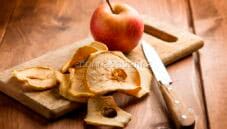
Oven-dried apples: nutritious chips that curb hunger
Oven-dried apples have an extra advantage As we've already mentioned, dried fruit chips can be eaten as a satisfying snack, but these dried apples can also be used as a great addition to breakfast...



